英文介绍中国文化
中国文化介绍英文版Chinese Culture introduction
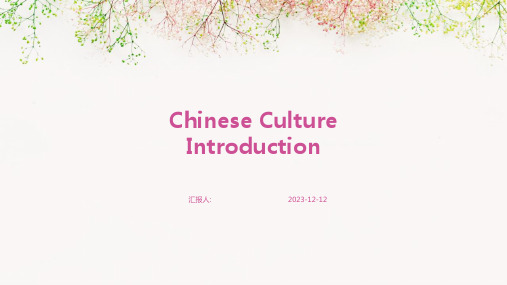
The commonly used techniques and styles in Chinese painting include ink painting, meticulous painting, freehand brushwork, etc., each with its unique aesthetic value and artistic expression.
Chinese Ceramics and Chinese Knives
Chinese porcelain is most famous for porcelain from Jingdezhen, Longquan Kiln, and other places, with a history dating back to the Tang Dynasty.
03
Buddhism and Zen Buddhism have a deep impact on Chinese culture, including Chinese poetry, calligraphy, painting, music, and folk customs They also spread to other countries and regions in the world
The Origin of Chinese Culture
The origin of Chinese culture can be traced back to the Yellow River basin, which is considered the slogan of Chinese civilization The Yellow River is an important river in China that has nurtured the growth of many urban civilizations
英文介绍中国传统文化
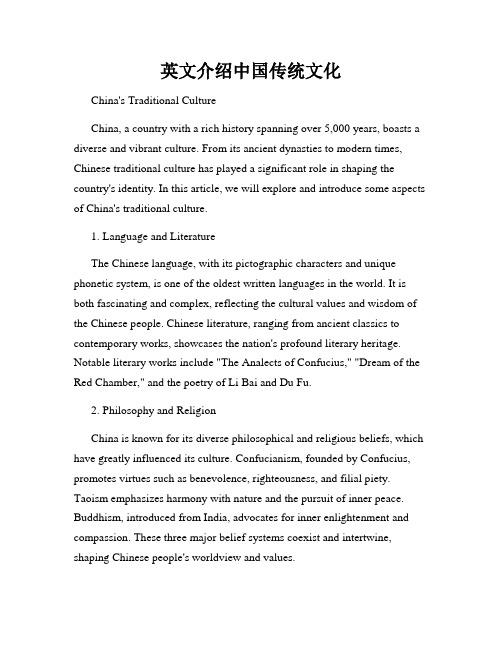
英文介绍中国传统文化China's Traditional CultureChina, a country with a rich history spanning over 5,000 years, boasts a diverse and vibrant culture. From its ancient dynasties to modern times, Chinese traditional culture has played a significant role in shaping the country's identity. In this article, we will explore and introduce some aspects of China's traditional culture.1. Language and LiteratureThe Chinese language, with its pictographic characters and unique phonetic system, is one of the oldest written languages in the world. It is both fascinating and complex, reflecting the cultural values and wisdom of the Chinese people. Chinese literature, ranging from ancient classics to contemporary works, showcases the nation's profound literary heritage. Notable literary works include "The Analects of Confucius," "Dream of the Red Chamber," and the poetry of Li Bai and Du Fu.2. Philosophy and ReligionChina is known for its diverse philosophical and religious beliefs, which have greatly influenced its culture. Confucianism, founded by Confucius, promotes virtues such as benevolence, righteousness, and filial piety. Taoism emphasizes harmony with nature and the pursuit of inner peace. Buddhism, introduced from India, advocates for inner enlightenment and compassion. These three major belief systems coexist and intertwine, shaping Chinese people's worldview and values.3. Traditional FestivalsChina has a wide array of traditional festivals, each with its unique customs and significance. The most well-known is the Spring Festival, also known as Chinese New Year, which marks the beginning of the lunar calendar. During this time, families gather for reunion dinners, exchange red envelopes containing money, and set off fireworks to ward off evil spirits. Other important festivals include the Lantern Festival, Qingming Festival, Dragon Boat Festival, Mid-Autumn Festival, and Double Ninth Festival.4. Traditional ArtsChinese traditional arts cover a broad range of disciplines, including calligraphy, painting, pottery, sculpture, opera, and martial arts. Calligraphy, regarded as a visual art form, embodies a spiritual expression of beauty and harmony. Chinese painting, characterized by brushstrokes and ink washes, often depicts landscapes, flowers, and birds. Traditional Chinese opera combines music, dance, and elaborate costumes to tell stories from Chinese history and folklore.5. Traditional Sports and GamesThroughout history, the Chinese have valued physical health and fitness. Traditional sports and games such as martial arts, table tennis, badminton, and mahjong have become deeply rooted in Chinese culture. Martial arts, such as Tai Chi and Kung Fu, not only promote physical well-being but also encompass a philosophical and spiritual dimension.6. CuisineChinese cuisine, with its diverse regional flavors and cooking styles, is renowned worldwide. From Sichuan spicy hot pot to Cantonese dim sum, each region has its unique culinary traditions. Chinese cuisine emphasizes the balance of flavors, textures, and colors. It includes a wide variety of ingredients and cooking techniques, demonstrating the Chinese people's deep appreciation for food and dining etiquette.ConclusionChina's traditional culture, with its rich heritage and diverse expressions, continues to be an essential part of its national identity. The language, literature, philosophy, festivals, arts, sports, and cuisine embody the values and traditions that have been passed down through generations. Understanding and appreciating China's traditional culture not only enhances our knowledge but also promotes cultural exchange and mutual respect in an increasingly interconnected world.。
介绍中华文化的英文作文怎么写_高考真题英语作文3篇

介绍中华文化的英文作文怎么写_高考真题英语作文3篇关于”介绍中华文化“的英语作文模板3篇,作文题目:Introduction to Chinese culture。
以下是关于介绍中华文化的高考英语模板,每篇作文均为真题模板带翻译。
关于”介绍中华文化“的英语作文模板3篇,作文题目:Introduction to Chinese culture。
以下是关于介绍中华文化的高考英语模板,每篇作文均为真题模板带翻译。
高分英语作文1:Introduction to Chinese cultureSan某ingdui site is a distance from the ancient Shuchuan cultural relics site, with an area of square kilometers at present. It is one of the important archaeological discoveries in the 20th century in China. It has been proved that the ancient Shu state had multi-directional characteristics derived from Chinese civilization thousands of years ago.中文翻译:三星堆遗址距古蜀川文化遗存遗址一段距离,目前面积达平方公里,是中国世纪重要考古发现之一的三星堆遗址和文物发现,几千年前就有力地证明了古蜀国存在着源于中华文明的多向性。
万能作文模板2:中国文化概论The people's Republic of China is an ancient oriental country with a long history. Chinese civilization, ancient Egyptian civilization, ancient Indian civilization and ancientBabylonian civilization constitute the territory of world civilization. What is most praiseworthy is that despite the war and the fusion of various nationalities, with the change of dynasties, the Chinese culture has a long history in terms of language, customs and culture, literature and art, and architectural style Therefore, China has rich historical and cultural tourism resources - Yin某u and pottery figurines, Qinshihuang, the Great Wall, Ming and Qing palaces, ancient towns, ancient towns, ancient towns, ancient towns, ancient towns, ancient towns, ancient towns, ancient towns, ancient towns, ancient towns, ancient towns, ancient towns, ancient towns, ancient towns, ancient towns, ancient towns, ancient towns, ancient towns, ancient towns, ancient towns, ancient towns, ancient towns, ancient towns, ancient towns, ancient towns, ancient towns, ancient towns, ancient towns, ancient towns, ancient towns, ancient towns, ancient towns, ancient towns, ancient Ancient town, ancient town, ancient town, ancient town, ancient town, ancient town, ancient town, ancient town, ancient town, ancient town, ancient town, people can ride horses on the grland, people can walk into the desert, hear the echo of camel bells at sunset, people can go to Tibet, stand in the nearest place from the sky, melt in the purest paradise in China, people can visit Jiuzhaigou and enjoy the most beautiful Water resources, people can visit Mount Tai and stand on a highland overlooking all the scenery in China.Even though the North has been covered with snow, people in the South still wear their T-shirts. Chinese land is a magical natural sculpture.中文翻译:中华共和国是一个历史悠久的东方古国,中华文明、古埃及文明、古印度文明、古巴比伦文明构成了世界文明的疆域,最值得称道的是,虽然历经战乱,各民族融合,随着朝代更迭,中华文明无论是语言文字、风俗文化、文学艺术、建筑风格,都有着源远流长的历史文化渊源,因此,中国拥有丰富的历史文化旅游资源,殷墟和陶俑秦始皇、长城、明清宫殿、古镇、古镇、古镇、古镇、古镇、古镇、古镇、古镇、古镇、古镇、古镇、古镇、古镇、古镇、古镇、古镇、古镇、古镇、古镇、古镇、古镇、古镇、古镇、古镇、古镇、古镇、古镇、古镇、古镇、古镇、古镇、古镇、古镇、古镇、古镇、古镇,人们可以在草原上骑马,人们可以走进沙漠,在日落时听到驼铃的回声人们可以去,站在离天空最近的地方,融化在中国最纯净的天堂里,人们可以游览九寨沟,欣赏最美的水资源,人们可以游览泰山,站在一个可以俯瞰中国所有风景的高地上,即使北方已经被白雪覆盖得很深,南方的人们仍然穿着他们的汗衫中国土地是一件神奇的自然雕刻作品。
中国传统文化英文作文范文

Introduction to Traditional Chinese CultureChina, with its rich history spanning thousands of years, boasts a diverse and vibrant traditional culture that has greatly influenced the world. This essay explores some key aspects of traditional Chinese culture.1. Confucianism and Filial Piety: Confucianism, founded by Confucius (551–479 BC), emphasizes moral values, family hierarchy, and respect for elders. Filial piety, the virtue of respecting and caring for one's parents and ancestors, is a cornerstone of Confucian ethics. It underscores the importance of family bonds and societal harmony.2. Chinese Language and Calligraphy: The Chinese language, with its intricate characters and rich symbolism, is one of the oldest written languages still in use today. Chinese calligraphy, regarded as a fine art form, combines brush strokes and artistic expression to convey meaning and beauty.3. Traditional Festivals: China celebrates numerous traditional festivals that reflect its cultural diversity and historical significance. These include the Spring Festival (Chinese New Year), Mid-Autumn Festival (Moon Festival), and Dragon Boat Festival. Each festival is accompanied by unique customs, rituals, and traditional foods.4. Chinese Cuisine: Chinese cuisine is renowned for its diversity, flavors, and regional variations. From spicy Sichuan dishes to delicate Cantonese dim sum, Chinese food emphasizes freshness, balance of flavors, and nutritious ingredients. Tea culture, with its elaborate rituals and ceremonies, also plays a significant role in Chinese culinary traditions.5. Traditional Arts and Performing Arts: Chinese traditional arts encompass a wide range of disciplines, including painting, sculpture, pottery, and crafts such as jade carving and silk embroidery. The performing arts, such as Peking Opera, Chinese dance, and traditional music played on instruments like the guzheng and pipa, showcase ancient storytelling and cultural expressions.6. Traditional Medicine and Philosophy: Traditional Chinese medicine (TCM) incorporates herbal remedies, acupuncture, and holistic approaches to health and wellness. It is based on the belief in the balance of Yin and Yang and the flow of Qi (life force) through the body. Taoism, another influential philosophy, emphasizes harmony with nature and spiritual cultivation.7. Architecture and Ancient Wisdom: Chinese architecture, characterized by pagodas, temples, and traditional courtyard houses (siheyuan), reflects both practicality and philosophical principles. Fengshui, the practice of arranging physical environments to harmonize with natural energies, is also integral to Chinese architectural and urban planning traditions.In conclusion, traditional Chinese culture is a treasure trove of wisdom, customs, and artistic achievements that continue to inspire and enrich the world. It reflects the values of harmony, respect for tradition, and a deep connection to nature and family. Understanding and appreciating traditional Chinese culture is essential for fostering cross-cultural understanding and appreciation in our globalized world.。
介绍中国传统文化的英文作文万能句子
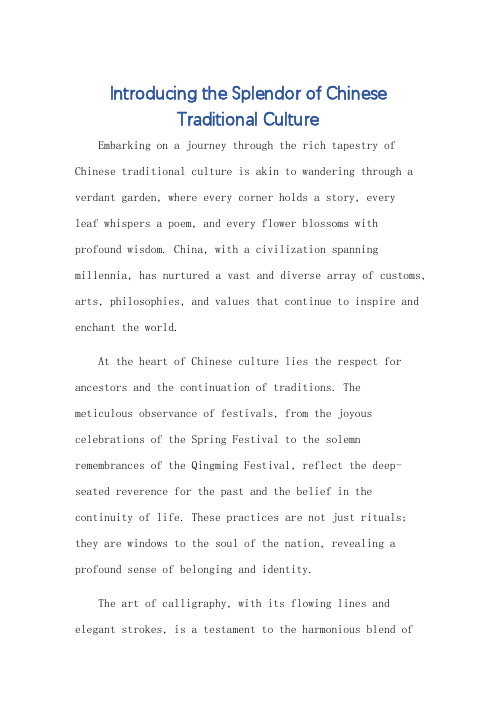
Introducing the Splendor of ChineseTraditional CultureEmbarking on a journey through the rich tapestry of Chinese traditional culture is akin to wandering through a verdant garden, where every corner holds a story, everyleaf whispers a poem, and every flower blossoms with profound wisdom. China, with a civilization spanning millennia, has nurtured a vast and diverse array of customs, arts, philosophies, and values that continue to inspire and enchant the world.At the heart of Chinese culture lies the respect for ancestors and the continuation of traditions. Themeticulous observance of festivals, from the joyous celebrations of the Spring Festival to the solemn remembrances of the Qingming Festival, reflect the deep-seated reverence for the past and the belief in the continuity of life. These practices are not just rituals; they are windows to the soul of the nation, revealing a profound sense of belonging and identity.The art of calligraphy, with its flowing lines and elegant strokes, is a testament to the harmonious blend ofaesthetics and philosophy in Chinese culture. Calligraphyis not just the art of writing; it is a meditation on life, a dance of ink and paper that captures the essence of the universe. Similarly, traditional Chinese painting, with its emphasis on留白 (leaving blank spaces) and the expression of spirit through form, embodies the philosophy of Yin and Yang, highlighting the balance and harmony inherent in all things.Chinese philosophy, particularly Confucianism, Taoism, and Buddhism, has shaped the ethical and moral fiber of the society. These philosophical systems, with their profound insights into human nature and the nature of the universe, have influenced not just Chinese civilization but also many other cultures worldwide. They promote virtues like filial piety, benevolence, righteousness, and wisdom, and advocate a harmonious coexistence with nature and society.The traditional performing arts of China, including opera, dance, and music, are vibrant expressions of the country's rich cultural heritage. These art forms, often a blend of storytelling, singing, and movement, captivate audiences with their dynamic presentations and deepemotional resonance. They not only entertain but also educate, passing down generations of wisdom and values through the power of storytelling.Moreover, Chinese cuisine, with its diverse flavors and intricate cooking techniques, is a culinary journey through the country's vast geographical and cultural landscapes. From the spicy flavors of Sichuan to the delicate tastes of Cantonese cuisine, each dish is a testament to thecreativity and ingenuity of Chinese chefs. Eating in China is not just a physiological need; it is an experience that engages all the senses and connects people to theircultural roots.In conclusion, Chinese traditional culture is a vast and vibrant mosaic of customs, arts, philosophies, and values that continue to inspire and enchant the world. Itis a legacy that deserves to be celebrated and preserved, not only for its historical significance but also for its timeless wisdom and beauty. As we journey through this garden of cultural riches, we are reminded of the enduring spirit of the Chinese people and the indelible influence of their culture on the world stage.**介绍中国传统文化的辉煌**踏上探寻中国传统文化丰富内涵的旅程,就如同漫步在一座生机勃勃的花园中,每一个角落都蕴藏着故事,每一片叶子都低语着诗篇,每一朵花都绽放着深邃的智慧。
有关中国传统文化的英文作文三篇
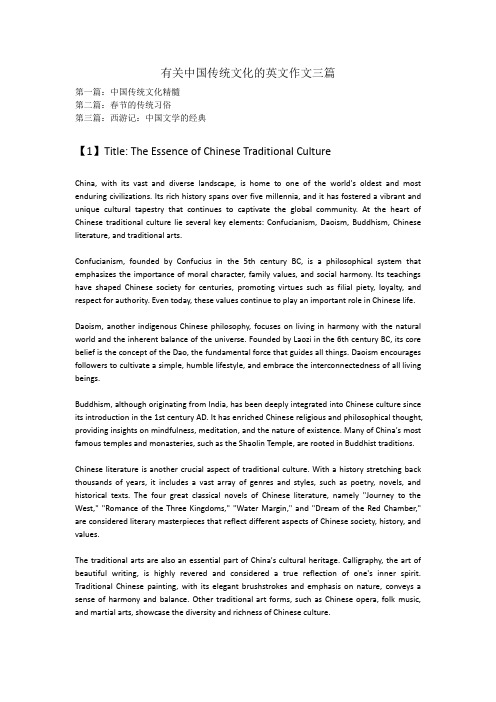
有关中国传统文化的英文作文三篇第一篇:中国传统文化精髓第二篇:春节的传统习俗第三篇:西游记:中国文学的经典【1】Title: The Essence of Chinese Traditional CultureChina, with its vast and diverse landscape, is home to one of the world's oldest and most enduring civilizations. Its rich history spans over five millennia, and it has fostered a vibrant and unique cultural tapestry that continues to captivate the global community. At the heart of Chinese traditional culture lie several key elements: Confucianism, Daoism, Buddhism, Chinese literature, and traditional arts.Confucianism, founded by Confucius in the 5th century BC, is a philosophical system that emphasizes the importance of moral character, family values, and social harmony. Its teachings have shaped Chinese society for centuries, promoting virtues such as filial piety, loyalty, and respect for authority. Even today, these values continue to play an important role in Chinese life.Daoism, another indigenous Chinese philosophy, focuses on living in harmony with the natural world and the inherent balance of the universe. Founded by Laozi in the 6th century BC, its core belief is the concept of the Dao, the fundamental force that guides all things. Daoism encourages followers to cultivate a simple, humble lifestyle, and embrace the interconnectedness of all living beings.Buddhism, although originating from India, has been deeply integrated into Chinese culture since its introduction in the 1st century AD. It has enriched Chinese religious and philosophical thought, providing insights on mindfulness, meditation, and the nature of existence. Many of China's most famous temples and monasteries, such as the Shaolin Temple, are rooted in Buddhist traditions.Chinese literature is another crucial aspect of traditional culture. With a history stretching back thousands of years, it includes a vast array of genres and styles, such as poetry, novels, and historical texts. The four great classical novels of Chinese literature, namely "Journey to the West," "Romance of the Three Kingdoms," "Water Margin," and "Dream of the Red Chamber," are considered literary masterpieces that reflect different aspects of Chinese society, history, and values.The traditional arts are also an essential part of China's cultural heritage. Calligraphy, the art of beautiful writing, is highly revered and considered a true reflection of one's inner spirit. Traditional Chinese painting, with its elegant brushstrokes and emphasis on nature, conveys a sense of harmony and balance. Other traditional art forms, such as Chinese opera, folk music, and martial arts, showcase the diversity and richness of Chinese culture.In conclusion, Chinese traditional culture is a multifaceted and enduring reflection of the nation's history, values, and beliefs. Its impact can be felt not only within China but also across the globe, as people from all walks of life are drawn to its unique charm and wisdom. As the world continues to evolve, Chinese traditional culture remains a source of inspiration and pride for the Chinese people and a testament to the resilience and creativity of human civilization.【2】Title: The Customs and Traditions of Chinese Spring FestivalThe Chinese Spring Festival, also known as Lunar New Year, is the most important and widely-celebrated holiday in China. It marks the beginning of the lunar calendar and is a time when families come together to welcome the new year with joy and prosperity. Rooted in centuries-old traditions, the Spring Festival embodies a rich tapestry of customs that have been passed down through generations. Here, we will delve into some of the most significant and fascinating practices associated with the festival.Preparations for the Spring Festival begin weeks in advance, with families cleaning their homes from top to bottom in a ritual known as "sweeping away the bad luck." This thorough cleaning is symbolic of driving away negative energy and making room for good fortune in the coming year. Homes are also adorned with red decorations, including lanterns, couplets, and paper cutouts, which represent happiness, prosperity, and good luck. Red, an auspicious color in Chinese culture, is believed to ward off evil spirits and bring good fortune.On the eve of the Spring Festival, families gather for a sumptuous reunion dinner, which is considered the most important meal of the year. The dinner table is laden with an array of dishes, each symbolizing a specific blessing for the new year. Fish, for example, represents abundance, while dumplings, with their-shaped like ancient gold ingots, symbolize wealth and prosperity. Family members indulge in these delicacies, sharing laughter and conversation as they usher in the new year together.One of the most well-known customs of the Spring Festival is the giving and receiving of red envelopes or "hongbao," which are filled with money. Traditionally, these envelopes are given by elders to younger family members as a symbol of their blessings and good wishes. The money inside the envelopes is believed to ward off evil spirits and bring good luck to the recipients in the coming year.Fireworks and firecrackers are also a prominent feature of the Spring Festival, as their loud explosions are believed to scare away evil spirits. Families and communities come together to light fireworks, filling the night sky with a dazzling spectacle of colors and sounds. This tradition has persisted for centuries, although some modern cities have introduced restrictions on fireworks to reduce air pollution and ensure safety.The Spring Festival celebrations culminate with the Lantern Festival, which falls on the fifteenthday of the first lunar month. During this time, streets and parks are illuminated with colorful lanterns, and people participate in riddle-solving games, enjoy traditional performances, and indulge in glutinous rice balls called "tangyuan," symbolizing family unity and togetherness.In conclusion, the customs and traditions of the Chinese Spring Festival reflect the richness and depth of Chinese culture. They embody the values of family, unity, and prosperity, while offering a fascinating glimpse into the beliefs and practices that have been passed down through generations. As the world becomes increasingly interconnected, the Spring Festival continues to captivate people of diverse cultures, who are drawn to its vibrant colors, tantalizing flavors, and profound symbolism.【3】Title: Journey to the West: A Classic of Chinese Literature"Journey to the West," also known as "Xiyouji" in Chinese, is one of the Four Great Classical Novels of Chinese literature. Written during the Ming Dynasty by Wu Cheng'en, the novel is a captivating blend of myth, legend, and adventure that has captured the hearts and imaginations of readers for centuries. This literary masterpiece not only provides a fascinating glimpse into Chinese history, culture, and beliefs, but also serves as a powerful allegory for spiritual growth and self-improvement.The story of "Journey to the West" is centered on the legendary pilgrimage of a Buddhist monk named Xuanzang, who travels from China to India in search of sacred Buddhist scriptures. Accompanying him on his perilous journey are four supernatural beings: Sun Wukong, the mischievous and resourceful Monkey King; Zhu Bajie, a pig-human hybrid with insatiable appetites for food and lust; Sha Wujing, a diligent and dependable river monster; and a white dragon horse that serves as Xuanzang's steed.Throughout the journey, Xuanzang and his companions encounter a myriad of challenges, including powerful demons, treacherous landscapes, and moral dilemmas. Each challenge serves as a test of their character, wisdom, and faith, ultimately shaping them into more virtuous and enlightened beings. While the narrative is filled with action, humor, and suspense, it also carries a deeper message about the importance of perseverance, compassion, and the transformative power of spiritual growth."Journey to the West" is notable for its rich and vivid portrayal of Chinese culture and mythology. The novel is steeped in Chinese folktales, legends, and Buddhist teachings, offering a unique window into the beliefs and values of ancient China. The characters in the story embody various aspects of human nature, such as courage, loyalty, cunning, and desire, providing valuable insights into the human condition.Furthermore, the novel has had a lasting impact on both Chinese and world literature. The character of Sun Wukong, the Monkey King, has become a symbol of rebellion, resourcefulness, and intelligence in Chinese culture. He has inspired countless adaptations, reinterpretations, andspin-offs, including the popular Japanese manga and anime series "Dragon Ball," which draws heavily from the character and themes of "Journey to the West."In conclusion, "Journey to the West" is a timeless classic of Chinese literature that continues to captivate and inspire readers from all walks of life. Its rich narrative, unforgettable characters, and profound messages about spiritual growth, resilience, and the human condition have solidified its status as a literary masterpiece. As the world becomes increasingly interconnected, the enduring appeal of "Journey to the West" is a testament to the power of stories to transcend cultural boundaries and unite people through the shared experience of imagination and wonder.。
中华传统文化英文介绍
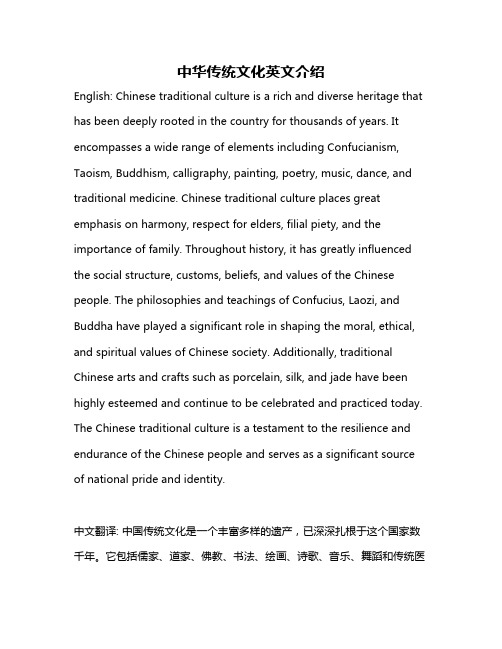
中华传统文化英文介绍English: Chinese traditional culture is a rich and diverse heritage that has been deeply rooted in the country for thousands of years. It encompasses a wide range of elements including Confucianism, Taoism, Buddhism, calligraphy, painting, poetry, music, dance, and traditional medicine. Chinese traditional culture places great emphasis on harmony, respect for elders, filial piety, and the importance of family. Throughout history, it has greatly influenced the social structure, customs, beliefs, and values of the Chinese people. The philosophies and teachings of Confucius, Laozi, and Buddha have played a significant role in shaping the moral, ethical, and spiritual values of Chinese society. Additionally, traditional Chinese arts and crafts such as porcelain, silk, and jade have been highly esteemed and continue to be celebrated and practiced today. The Chinese traditional culture is a testament to the resilience and endurance of the Chinese people and serves as a significant source of national pride and identity.中文翻译: 中国传统文化是一个丰富多样的遗产,已深深扎根于这个国家数千年。
向国外同学介绍中国文化英语作文
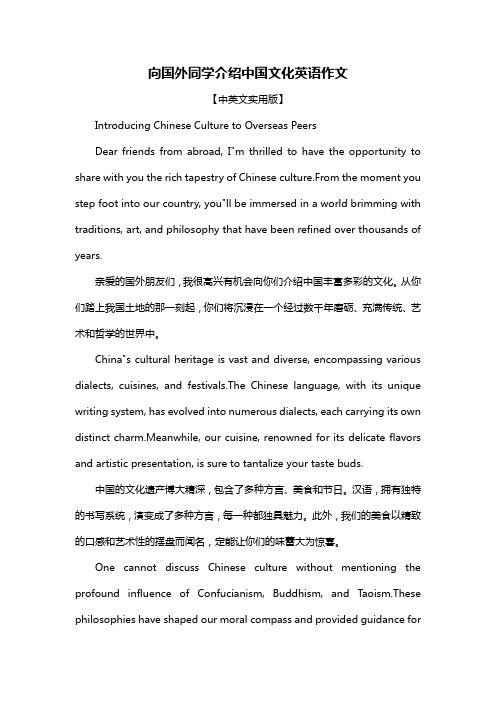
向国外同学介绍中国文化英语作文【中英文实用版】Introducing Chinese Culture to Overseas PeersDear friends from abroad, I"m thrilled to have the opportunity to share with you the rich tapestry of Chinese culture.From the moment you step foot into our country, you"ll be immersed in a world brimming with traditions, art, and philosophy that have been refined over thousands of years.亲爱的国外朋友们,我很高兴有机会向你们介绍中国丰富多彩的文化。
从你们踏上我国土地的那一刻起,你们将沉浸在一个经过数千年磨砺、充满传统、艺术和哲学的世界中。
China"s cultural heritage is vast and diverse, encompassing various dialects, cuisines, and festivals.The Chinese language, with its unique writing system, has evolved into numerous dialects, each carrying its own distinct charm.Meanwhile, our cuisine, renowned for its delicate flavors and artistic presentation, is sure to tantalize your taste buds.中国的文化遗产博大精深,包含了多种方言、美食和节日。
介绍中国传统文化的英文作文万能句子
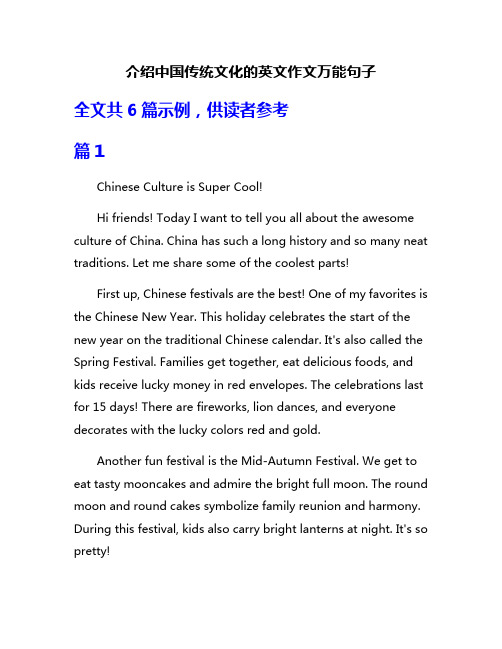
介绍中国传统文化的英文作文万能句子全文共6篇示例,供读者参考篇1Chinese Culture is Super Cool!Hi friends! Today I want to tell you all about the awesome culture of China. China has such a long history and so many neat traditions. Let me share some of the coolest parts!First up, Chinese festivals are the best! One of my favorites is the Chinese New Year. This holiday celebrates the start of the new year on the traditional Chinese calendar. It's also called the Spring Festival. Families get together, eat delicious foods, and kids receive lucky money in red envelopes. The celebrations last for 15 days! There are fireworks, lion dances, and everyone decorates with the lucky colors red and gold.Another fun festival is the Mid-Autumn Festival. We get to eat tasty mooncakes and admire the bright full moon. The round moon and round cakes symbolize family reunion and harmony. During this festival, kids also carry bright lanterns at night. It's so pretty!Speaking of food, Chinese cuisine is out of this world! There are so many flavors and regional styles. My favorites are dumplings, noodles, and Peking duck. Mmm, my mouth is watering just thinking about it! An important part of the meal is using chopsticks to eat. It takes practice, but once you get the hang of it, chopsticks are super cool to use.Chinese arts and crafts are amazing too. One example is calligraphy - the beautiful art of fancy writing and brushwork. The tools are a brush, ink stone, and rice paper. Writing the characters looks almost like a dance! Another craft is paper folding called zhezhi. You can make clever designs like dragons and phoenixes just by folding pieces of paper in special ways.Then there are the famous Chinese inventions that changed the world! Things you might use every day like paper, printing, the compass, and gunpowder were first created in ancient China. Can you imagine your life without those handy items? Pretty crazy, right?Those are just a few highlights of the rich Chinese culture. There is still so much more I could discuss, like traditional Chinese medicine, martial arts, silk making, jade carving, and ancient philosophical teachings. China has contributed countlesscustoms, innovations, and wisdom to human civilization over its 5,000 year history.I feel so lucky to be able to learn about my cultural roots from a young age. The Chinese traditions of honor, discipline, creativity and diligence will help guide me to become a good person. While modern life is rapidly changing, it's important to keep these long-standing values alive. I hope more people around the world can come to appreciate the splendor and significance of Chinese culture!篇2My Favorite Chinese TraditionsHi there! My name is Xiao Ming and I'm 10 years old. I live in Beijing with my mom, dad, and little sister Mei Mei. Today I want to tell you about some of my favorite parts of Chinese culture that my family celebrates and practices.One of the biggest traditions is Chinese New Year! This is the most important holiday we celebrate each year. Everything starts with a huge cleaning of the whole house to sweep away bad luck from the old year. Then my mom buys lots of yummy snacks and fresh fruit. We decorate with red lanterns, couplets with good luck sayings, and paintings of the zodiac animal for that year.On New Year's Eve, our whole family gets together for a huge feast called the Reunion Dinner. We have all kinds of delicious dishes like dumplings, noodles for long life, whole steamed fish for abundance, and sweet rice balls. After dinner, we stay up late setting off firecrackers and fireworks at midnight to ring in the new year!The next day, it's tradition to wake up early and dress in new clothes from head to toe for good luck. Kids like me get hung bao, which are little red envelopes with money inside as a gift. We're not allowed to sweep or take out trash for a couple weeks so we don't sweep away the good luck. For two weeks, there are lion dances, temple fairs, and dragon dances in the streets to celebrate!Another big tradition is the Mid-Autumn Festival. This holiday honors the big, bright, beautiful full moon. A couple weeks before, my grandma teaches my sister and me to make mooncakes. These are thick pastries stuffed with lotus seed paste or other fillings, and they are shaped like the full moon.On the night of the festival, my whole family gets together to eat mooncakes and sip tea under the moon. We try to spot the jade rabbit on the moon's surface! My favorite part is carrying brightly glowing lanterns shaped like animals through the parkwith all my cousins. Shanghai has the biggest lantern festival I've ever seen.Speaking of lanterns, another fun tradition is for the Lantern Festival at the end of New Year celebrations. My dad is an artist, so he always makes the most beautiful lanterns for us to hang up around the house and courtyard. When I was little, we would go to temple fairs and watch dragon dances weaving through the streets between bright, swaying lanterns. Now that I'm older, I get to carry a lantern myself in the evening parade!Chinese culture is filled with so many other amazing traditions too. I love hearing the legends behind them from my grandparents. Like the story of the household gods who check on each family before New Year and report to the Jade Emperor in heaven. Or the tale of Zhi Nu the cloud weaver and Niu Lang the cowherd, whose forbidden love is honored on Qixi or the Double Seventh Festival.Another favorite is Qingming Festival in the spring, when we visit our ancestors' graves, burn incense, and make offerings of their favorite foods and fresh flowers. It reminds me of the importance of honoring those who came before us.There are so many brilliant Chinese inventions that are still used today too! Printing, paper making, the compass,gunpowder, the abacus for math—all of these amazing things originated in ancient China. We even had the first robot! It was an automatic wine server made of bamboo and string.I'm also very proud of Chinese arts and crafts like calligraphy, painting, paper cutting, jade carving, kite making, pottery, and embroidery. My aunt is an incredible painter and she teaches me Chinese brush painting techniques. I'm trying to learn to write with a brush and ink too.Chinese medicine is fascinating as well. Practitioners use herbs, acupuncture, massage, and practices like tai chi and qigong to promote health and balance in the body. My grandpa does tai chi in the park every morning and says it's a great way to start the day.There are just so many brilliant accomplishments, beautiful arts, delicious cuisine, ancient philosophies, and fun celebrations in Chinese culture. I feel very lucky to be able to participate in these rich traditions. Maybe you'd like to experience some too! Let me know if you have any other questions.篇3Traditional Chinese Culture is Super Cool!Hey there! I'm going to tell you all about the awesome traditional culture from China. It's been around for thousands of years and has so many fascinating parts to it. Get ready to learn some really neat stuff!First up, let's talk about Chinese characters. They look like beautiful little pieces of art, with each one representing a word rather than just a letter sound. Writing in Chinese characters takes a ton of practice, but once you get the hang of it, it's almost like painting a mini picture every time you write something down. There are so many characters too - tens of thousands! My grandparents can read and write way more than I can.Speaking of my grandparents, a big part of Chinese culture is respect for elders and ancestors. We have special holidays just for honoring our older family members and those who came before us. During festivals like Qingming, we visit the graves of our ancestors, clean them up, and leave offerings of food, flowers and incense. On the Lunar New Year, kids get lucky red envelopes with money inside from the grown-ups. It's a way of passing on good fortune.Then there are all the amazing Chinese arts and crafts. Calligraphy is the beautiful handwriting of Chinese characters.True masters can make the ink flow and dance across the paper. Chinese painting has been around for ages, capturing landscapes, flora and fauna with detailed brushstrokes. My favorite is probably paper cutting though - creating intricate designs by folding and snipping away at colorful paper. It's almost like magic!I can't talk about Chinese culture without mentioning the food! Oh man, the food is out of this world delicious. Every region has its own special dishes and flavors. In the north, they love doughy things like dumplings and noodles. In the south, the cuisine features lots of rice and seafood. Then you've got Sichuan food which is crazy spicy but so tasty. My mouth waters just thinking about it!Two philosophies that are really important in Chinese thinking are Taoism and Confucianism. Taoism teaches ideas like going with the flow and finding balance and harmony in nature. Confucianism is more about ethics, morals, and social roles. Showing respect, working hard, and being a good person are key Confucian values. Both have influenced Chinese culture immensely over the centuries.I could ramble on forever about Chinese martial arts like kung fu, traditional medicine practices, Beijing Opera with all itsbright costumes and masks, or Chinese inventions like the compass, gunpowder, and printing. But I'll stop here so I don't overload your brain!Chinese culture is just endlessly fascinating to me. From the very first script carved into oracle bones to the modern skyscrapers of cities like Shanghai, it has such an amazingly long and rich history. Preserving traditions while also adapting to new times is something the Chinese people have done brilliantly over the millennia. I'm so fortunate to be part of this wonderful heritage. If you ever get the chance to experience aspects of traditional Chinese culture, I highly recommend it!篇4Chinese Culture is Awesome!Hi friends! Today I want to tell you all about the amazing culture of China. There's just so much to share about the oldest continuous civilization on Earth. Get ready to learn some super cool stuff!Let's start with Chinese writing. Did you know Chinese characters are one of the oldest written languages still in use? The earliest written characters date back over 3,000 years! Modern Chinese has tens of thousands of characters, whichoriginate as small pictures representing objects, ideas or sounds.I think it's awesome how each little squiggle holds such deep meaning.Chinese arts and crafts are renowned worldwide for their beauty and craftsmanship. Take ceramics for example - Chinese potters were the first to develop fired glazes, way back in the Shang Dynasty over 3,500 years ago! They made gorgeous glazed stoneware in vibrant colors like jade green and sapphire blue. Chinese silk is another famous export, originally reserved only for imperial royalty. It comes from the silkworm, and its production was a closely guarded secret for centuries.Speaking of secrets, let me tell you about Chinese martial arts! Styles like kung fu, with its rapid kicks and punches, actually originated as military training over 2,000 years ago. Masters studied not just combat, but meditation, philosophy and traditional medicines too. So cool!Chinese philosophy has had a huge impact on culture over the millennia. There's Confucianism, which emphasizes ethics, propriety and social harmony. Confucius was a wise teacher who lived around 500 BC. His philosophy guides relationships, from family to government. Then there's Taoism, focused on livingsimply and in harmony with nature. The famous Taoist Book of Changes is over 3,000 years old!No introduction to Chinese culture would be complete without mentioning the amazing architecture. The Forbidden City in Beijing is a massive 180-acre palace compound with nearly 1,000 buildings! It was home to 24 emperors during the Ming and Qing dynasties. With its red walls, yellow glazed roof tiles, white marble and intricate carved wood, it's a breathtaking example of traditional palace architecture.And then there are the amazing festivals! Chinese New Year is the biggest, with red lanterns, fireworks, dumplings and giving out red envelopes with money inside for good luck. TheMid-Autumn Festival celebrates the fall harvest with mooncakes and colorful lanterns. During Qingming Festival, families visit ancestor graves to pay respects. The Dragon Boat Festival has super exciting boat races and eating zongzi, sticky rice wrapped in bamboo leaves!Oh man, I could go on and on about China's rich heritage. From jade carvings to shadow puppetry, from traditional medicine to the games of go and mahjong, there's just so much awesome stuff! Four thousand years of continuous history have created one of the most vibrant and profound cultures on ourplanet. I hope you've enjoyed learning a bit about the wonders of Chinese civilization. It really is something every kid should know about. Thanks for reading, and let me know if you have any other questions!篇5China Has Such Cool Traditions!Did you know that China is one of the oldest civilizations in the world? It has a really rich culture filled with amazing customs, celebrations, and philosophies that have been passed down for thousands of years. Let me tell you about some of the coolest traditions from my awesome country!One of the biggest holidays in China is Chinese New Year. It's kind of like Christmas, but way more exciting! The celebration lasts for 15 whole days. On New Year's Eve, families get together for a huge feast with dishes like dumplings, noodles, fish, and sticky rice cakes. We decorate our houses with red lanterns, couplets, and paper cuts. The color red is super lucky. At midnight, we set off a ton of firecrackers and fireworks to scare away evil spirits. How awesome is that?For the next two weeks, we visit relatives and friends, eat delicious foods, watch dragon and lion dances, and get redenvelopes filled with money! My favorite part is whenthewhole neighborhood comes alive with festivities. There are dragon parades with people dressed up in vibrant costumes juggling balls and ribbons. It's such a joyful, lively celebration of the new year.Speaking of dragons, they are very important in Chinese mythology and culture. They symbolize power, strength, and good luck. You see dragon images and motifs everywhere - on buildings, clothing, artwork. Chinese dragons look way cooler than Western dragons too. Ours have long, snake-like bodies covered in scales, with four legs and expressive faces. Some have deer-like antlers or flowing manes. Ancient rulers even used the dragon symbol to represent their imperial power.Another super important tradition is the philosophy of yin and yang. It's the idea that all things in the universe have two opposing but complementary forces - the yin (dark, feminine, passive) and the yang (light, masculine, active). These energies need to be balanced and harmonious for there to be order in the world. The yin yang symbol, with the swirl of black and white teardrops, represents this concept. It reminds us that within each opposing force contains a seed of the other. Pretty deep for such a simple design, right?I can't forget to mention some Chinese martial arts, which are over 2,000 years old! Kung fu movies with guys doing crazy kicks and punches are popular worldwide. But the practice of kung fu is not just about fighting. It emphasizes moral ethics, spiritual discipline, and finding inner peace. Some of thebest-known styles are Shaolin kung fu, with its intense training at the ancient Shaolin Buddhist monastery, and tai chi, with its slow, graceful movements. Martial arts masters have almost superhuman abilities - they can smash concrete with their heads, walk on sharp nails, and use secret pressure points to defeat opponents!Those are just a few highlights of China's awesome cultural heritage. There's so much more I could tell you about - traditional Chinese medicine, calligraphy, opera, literature, crafts, and architecture. Just exploring Beijing's Forbidden City palace or walking along the Great Wall gives you a sense of China's grand history and traditions. I feel really lucky to come from such an ancient, rich civilization. Don't you think Chinese culture is amazing? I can't wait to learn more about it as I get older!篇6My Awesome Chinese CultureChina is an amazing country with a super long history and lots of awesome culture! I love learning about the traditions of my homeland. Here are some of the coolest parts of Chinese culture:FoodYum, yum, yum! Chinese food is the best. We have so many delicious dishes and snacks. My favorites are dumplings, noodles, and Peking duck. Dumplings are little pouches stuffed with tasty fillings like pork and vegetables. You can boil them, steam them, or fry them. Noodles come in long strings that you slurp up. And Peking duck is a whole roasted duck with crispy skin that gets brushed with a sweet sauce. My mouth is watering just thinking about it!Another Chinese food tradition is to use chopsticks instead of forks and spoons. Chopsticks are two skinny sticks that you hold in one hand to pick up food. It takes practice to get good at using chopsticks, but once you learn, it's fun!FestivalsChina celebrates a lot of exciting festivals every year. My favorite is the Chinese New Year! It's also called the Spring Festival. This holiday lasts for 15 days and is a time for familyreunions, eating special foods, and setting off fireworks and firecrackers. Houses get decorated with red lanterns, couplets, and papercuts. Kids receive red envelopes filled with money as gifts. The loud fireworks are supposed to scare away evil spirits for the new year.Another big celebration is the Mid-Autumn Festival. It happens when the moon is roundest and brightest in the fall. Families get together to admire the full moon, eat mooncakes (a dense sweet cake), and share the legend of Chang'e, the mythical lady on the moon.Arts and CraftsThe traditional arts and crafts of China are awesome! I love the ink wash paintings of landscapes with their soft brushstrokes and splashes of black ink. Chinese calligraphy, or brush writing, is also beautiful. The calligraphers have to practice for years to perfect the elegant flowing strokes.One of the coolest Chinese crafts is paper folding and cutting. People fold and snip away at colorful paper to create intricate designs called paper cuts. They are usually designs of characters, animals, or flowers with lots of tiny, detailed cuts. The papercuts are used to decorate windows or lanterns for festivals.Another traditional craft is making clay figurines. Little statues of people, animals, and mythical creatures are molded and painted with bright colors and patterns. During holidays, every household will display these vibrant clay figurines.Beliefs and StoriesChina has a lot of fascinating traditional beliefs and folk tales that have been passed down for thousands of years. Many of the stories try to teach good values like being kind, working hard, and respecting your elders.For example, there is the legend of the Jade Rabbit. As the story goes, a poor rabbit once jumped into a fire to provide food for the hungry. The rabbit's noble sacrifice was so brave that the gods were touched. They immortalized the rabbit by placing its image on the moon as a symbol of selflessness.Other myths tell about deities and supernatural creatures. The Dragon King is said to be the ruler of all waters and ability to control rain and floods. The Phoenix is a magical bird that appears only in times of peace and prosperity as a symbol of harmony. I love hearing about these magical tales!China has many traditional beliefs about luck, fortune, and symbolism too. The numbers 8 and 9 are considered very lucky,while 4 is unlucky. Certain colors, animals, and objects are seen as auspicious symbols for good luck, wealth, longevity, or fertility. For instance, goldfish represent abundance, while cranes signify long life.Traditional ClothingChinese people have such awesome traditional styles of dress. Many outfits feature bright colors, elaborate patterns, and intricate knots or fastenings.For ladies, there is the qipao or cheongsam dress. This is a tight-fitting dress with a high collar and fancy patterns and frog button closures up the sides. Another beautiful women's garment is the long trailing dress with billowing sleeves called an ao dai.For men, the traditional look is a long silk robe called a changshan. It has a mandarin collar and may be plain or decorated with embroidery and knotted buttons.Many of the clothes, accessories, and shoes incorporate symbols like dragons, phoenixes, peonies, or geometric shapes that were thought to bring good luck and fortune. Even the knots and fasteners could carry meanings of health, wealth, or long life.I feel so proud learning about the incredible traditions, arts, and culture of my Chinese heritage. China has such a depth of rich customs that have been carefully passed down from ancient times until today. I hope you found some parts of it interesting too! Let me know if you want to hear more awesome details about life in the Middle Kingdom.。
中国传统文化介绍(英文版)
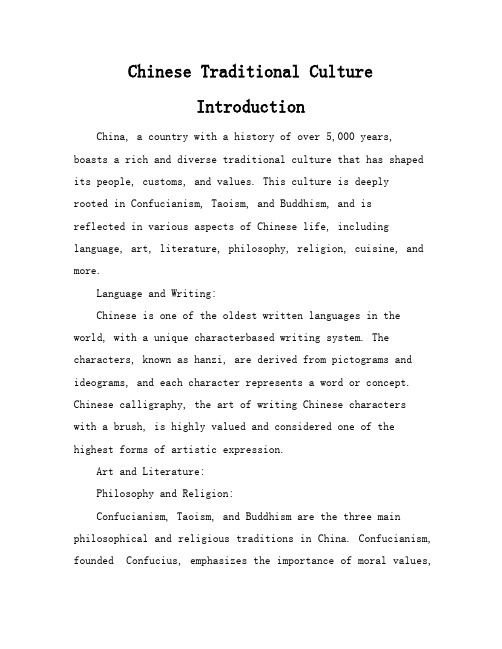
Chinese Traditional CultureIntroductionChina, a country with a history of over 5,000 years, boasts a rich and diverse traditional culture that has shaped its people, customs, and values. This culture is deeplyrooted in Confucianism, Taoism, and Buddhism, and isreflected in various aspects of Chinese life, including language, art, literature, philosophy, religion, cuisine, and more.Language and Writing:Chinese is one of the oldest written languages in the world, with a unique characterbased writing system. The characters, known as hanzi, are derived from pictograms and ideograms, and each character represents a word or concept. Chinese calligraphy, the art of writing Chinese characterswith a brush, is highly valued and considered one of the highest forms of artistic expression.Art and Literature:Philosophy and Religion:Confucianism, Taoism, and Buddhism are the three main philosophical and religious traditions in China. Confucianism, founded Confucius, emphasizes the importance of moral values,social harmony, and filial piety. Taoism, founded Laozi, emphasizes the pursuit of harmony with nature and the Tao, or the Way. Buddhism, which originated in India, focuses on the Four Noble Truths and the Eightfold Path as a means to achieve enlightenment and escape suffering.Cuisine:Chinese cuisine is one of the most diverse and flavorful in the world, with a wide variety of regional styles and dishes. Some of the most famous Chinese dishes include Peking duck, dim sum, hot pot, and dumplings. Chinese cooking techniques are also diverse, including stirfrying, steaming, boiling, and roasting.Festivals and Celebrations:China has a rich tradition of festivals and celebrations, many of which are based on the lunar calendar. Some of the most important festivals include the Spring Festival (Chinese New Year), the MidAutumn Festival, the Dragon Boat Festival, and the Lantern Festival. These festivals are celebrated with traditional customs, such as lighting lanterns, eating special foods, and watching fireworks.Traditional Medicine:Traditional Chinese medicine (TCM) is a holistic system of medicine that has been practiced for thousands of years. TCM emphasizes the balance of yin and yang, and the use ofherbal remedies, acupuncture, and other treatments to promote health and wellbeing.Conclusion:Chinese traditional culture is a treasure trove of knowledge, wisdom, and beauty. It continues to influence the lives of people in China and around the world, and is a valuable resource for understanding the history and development of human civilization.ContinuedArchitecture and Gardens:Chinese architecture is renowned for its intricate designs, use of wood, and emphasis on harmony with nature. Traditional Chinese buildings often feature curved roofs, red columns, and decorative elements such as dragons and phoenixes. Chinese gardens, known for their balance of water, rocks, plants, and architecture, are designed to create a serene and contemplative atmosphere.Music and Dance:Chinese music has a long history, with various instruments such as the guqin (a sevenstringed zither), erhu (a twostringed fiddle), and pipa (a fourstringed lute). Traditional Chinese dance is also diverse, ranging from优雅的宫廷舞到欢快的民间舞,每一种舞蹈都有其独特的风格和意义。
中国文化英语作文
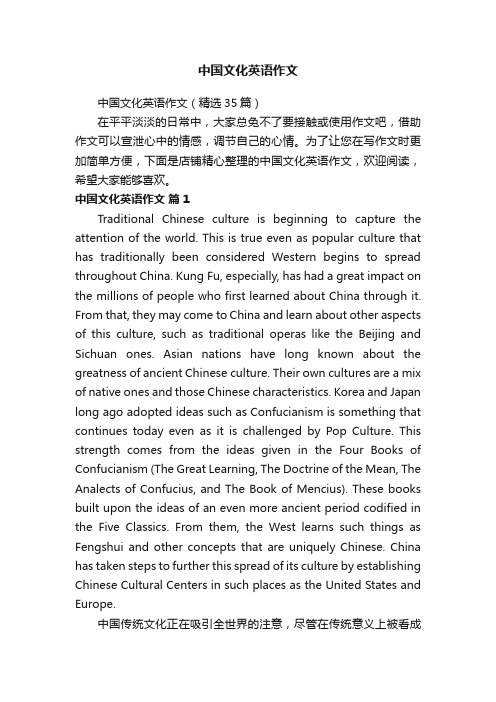
中国文化英语作文中国文化英语作文(精选35篇)在平平淡淡的日常中,大家总免不了要接触或使用作文吧,借助作文可以宣泄心中的情感,调节自己的心情。
为了让您在写作文时更加简单方便,下面是店铺精心整理的中国文化英语作文,欢迎阅读,希望大家能够喜欢。
中国文化英语作文篇1Traditional Chinese culture is beginning to capture the attention of the world. This is true even as popular culture that has traditionally been considered Western begins to spread throughout China. Kung Fu, especially, has had a great impact on the millions of people who first learned about China through it. From that, they may come to China and learn about other aspects of this culture, such as traditional operas like the Beijing and Sichuan ones. Asian nations have long known about the greatness of ancient Chinese culture. Their own cultures are a mix of native ones and those Chinese characteristics. Korea and Japan long ago adopted ideas such as Confucianism is something that continues today even as it is challenged by Pop Culture. This strength comes from the ideas given in the Four Books of Confucianism (The Great Learning, The Doctrine of the Mean, The Analects of Confucius, and The Book of Mencius). These books built upon the ideas of an even more ancient period codified in the Five Classics. From them, the West learns such things as Fengshui and other concepts that are uniquely Chinese. China has taken steps to further this spread of its culture by establishing Chinese Cultural Centers in such places as the United States and Europe.中国传统文化正在吸引全世界的注意,尽管在传统意义上被看成是西方文化的流行文化开始在中国广泛传播。
中国传统文化介绍(英文版)

Introduction to Chinese TraditionalCultureChina, with a history spanning over 5,000 years, boasts a rich and profound traditional culture that has shaped the country's identity and influenced countless aspects of daily life. This document aims to provide an overview of Chinese traditional culture, highlighting its key elements and their significance in Chinese society.1. Language and Literature2. Philosophy and ReligionChinese traditional culture is deeply rooted in Confucianism, Taoism, and Buddhism. Confucianism emphasizes the importance of moral integrity, respect for authority, and the pursuit of harmony in relationships. Taoism advocates for a simple, natural life and the pursuit of inner peace. Buddhism, introduced from India, has integrated with Chinese culture, influencing art, architecture, and everyday life.3. Art and CraftsmanshipChinese art is renowned for its exquisite craftsmanship and aesthetic appeal. Traditional Chinese painting, calligraphy, and porcelain are highly valued worldwide. The art of silk weaving, papermaking, and jade carving showcasesthe ingenuity and skill of Chinese artisans. Moreover, the practice of Feng Shui, which aims to harmonize the flow of energy in a space, reflects the Chinese belief in the interconnectedness of nature and human life.4. Festivals and CustomsChinese festivals are a vibrant display of the country's cultural heritage. The Spring Festival (Chinese New Year) is the most important holiday, featuring traditional activities such as dragon and lion dances, fireworks, and family reunions. Other notable festivals include the Lantern Festival, Dragon Boat Festival, and MidAutumn Festival, each with its unique customs and traditions.5. Traditional ClothingThe Hanfu, a traditional Chinese attire, reflects the elegance and diversity of Chinese culture. Characterized its flowing lines and vibrant colors, Hanfu represents different social status, occasions, and historical periods. The Tang suit and Qipao are also iconic examples of Chinesetraditional clothing, showcasing the beauty and grace of Chinese women.In conclusion, Chinese traditional culture is a treasure trove of wisdom, art, and values that continue to shape the lives of people in China and around the world. By exploringthese cultural elements, we can gain a deeper understandingof the Chinese perspective on life, nature, and humanity.6. Culinary DelightsChinese cuisine is a vital part of its traditional culture, renowned for its diversity and emphasis on harmonyin flavors and ingredients. The practice of using a pair of chopsticks is not only a dining custom but also a reflectionof Chinese philosophy. Signature dishes such as Peking duck, hot pot, dim sum, and Sichuan spicy tofu (Mapo tofu)represent the rich tapestry of regional cuisines within China. The art of tea making and tea ceremonies further illustratethe Chinese pursuit of balance and tranquility in daily life.7. Architecture and GardensChinese architecture is characterized its use of wood, intricate carvings, and upturned eaves. The Forbidden City in Beijing and the classical gardens of Suzhou are prime examples of Chinese architectural excellence. Thesestructures are not only beautiful but also embody theprinciples of Feng Shui and the concept of harmony between humanity and nature. The gardens, in particular, are designed to mimic natural landscapes, providing a serene environmentfor contemplation and relaxation.8. Music and DanceChinese traditional music, with its unique scales and instruments such as the guzheng (zither), erhu (fiddle), and pipa (lute), creates a distinctive sound that is both soothing and evocative. Chinese classical dance, often performed in colorful costumes with flowing movements, tells stories and expresses emotions, drawing from historical legends and folk tales. The Peking Opera, with its elaborate costumes, makeup, and singing styles, is a famous form of traditional Chinese performing art.9. Martial Arts10. Social EtiquetteChinese society places a strong emphasis on respect, modesty, and humility. The concept of "face" (mianzi) is crucial in social interactions, representing one's reputation and social standing. Traditional greetings, such as bowing or clasping hands, and the exchange of business cards with both hands, demonstrate the importance of etiquette in Chinese culture. The practice of giftgiving, with its specific customs and taboos, is also a reflection of the respect and consideration shown in relationships.In exploring the depths of Chinese traditional culture, one cannot help but be inspired its richness and the enduring legacy it has left on the world. It is a culturethat invites us to look inward, to appreciate the beauty in simplicity, and to find harmony in the world around us.11. Folklore and MythologyChinese folklore and mythology are a tapestry of stories and legends that have been passed down through generations. These tales often feature mythical creatures like the dragon, phoenix, and qilin, which symbolize power, prosperity, and good fortune. Stories such as "Journey to the West," "Water Margin," and "The Investiture of the Gods" are not only literary masterpieces but also reflect the moral values and cultural norms of ancient China. These myths and legends continue to influence modern Chinese literature, film, and popular culture.12. Traditional Medicine13. Family ValuesFamily is the cornerstone of Chinese society, and traditional values place a strong emphasis on filial piety and ancestor worship. Elders are respected for their wisdom and experience, and the concept of "family" extends beyond the nuclear unit to include extended relatives. The family name (surname) is a source of pride and identity, often passed down through generations with a sense of duty to honor one's ancestors. The importance of family is reflected in thecelebration of festivals, where family reunions are a central tradition.14. Education and the Art of LearningEducation has always been highly valued in Chinese culture, with a focus on the pursuit of knowledge and the cultivation of moral character. The ancient Chinese education system emphasized the Four Arts: qin (a string instrument), shu (calligraphy), hua (painting), and qi (the game of Go). Today, the Chinese education system continues to be rigorous, with a strong emphasis on academic achievement and the Confucian values of respect for teachers and the importance of learning.15. Ceremonies and RitualsChinese culture is rich with ceremonies and rituals that mark life's milestones, such as births, weddings, and funerals. These events are often steeped in tradition, with specific customs and rituals that have been followed for centuries. For instance, Chinese weddings are filled with symbolic gestures, such as the exchange of red envelopes (hongbao), the tea ceremony, and the wearing of traditional attire. These rituals are not only celebratory but also serve to reinforce cultural identity and continuity.In conclusion, the depth and breadth of Chinesetraditional culture are truly aweinspiring. It is a livingheritage that continues to evolve while maintaining its roots in ancient wisdom. By understanding and appreciating these cultural elements, we gain insight into the soul of a civilization that has shaped and continues to shape the world in countless ways.。
介绍中国优秀文化的英文演讲稿

Title: Introduction to China's Outstanding CultureLadies and gentlemen,1. IntroductionChina, as one of the world's oldest civilizations, has a rich and diverse cultural heritage that spans thousands of years. Today, I am honored to present to you an introduction to China's outstanding culture, highlighting its key elements and contributions to the world.2. Traditional Chinese philosophyOne of the defining aspects of Chinese culture is its profound philosophical traditions. Dating back to the teachings of Confucius, Laozi, and many other ancient scholars, traditional Chinese philosophy emphasizes the principles of harmony, respect, and moral cultivation. These philosophical ideas have greatly influenced Chinese society, governance, and interpersonal relationships, and continue to resonate with people around the world.3. Chinese language and calligraphyThe Chinese language, with its unique logographic writingsystem, is one of the world's oldest and most enduring written languages. Chinese calligraphy, as a highly regarded art form, embodies the beauty and elegance of the language. The strokes and flourishes of Chinese characters convey deeper meanings and evoke a sense of aesthetic appreciation that transcends cultural boundaries.4. Literature and poetryChinese literature and poetry have a long and distinguished history, with a rich tradition of storytelling, classical prose, and lyrical verse. The works of renowned writers such as Li B本人, Du Fu, and Su Shi have left an indelible mark on the literary world, inspiring generations with their profound insights, vivid imagery, and emotional depth.5. Traditional Chinese medicineAn integral part of Chinese culture, traditional Chinese medicine (TCM) has evolved over thousands of years and epasses a range of practices, such as acupuncture, herbal medicine, and qigong. TCM emphasizes a holistic approach to health and well-being, focusing on the balance of yin and yang energies, and has g本人ned recognition for its efficacy and therapeutic benefits in addressing various health conditions.6. Performing artsChinese performing arts, including opera, traditional dance, and music, showcase the vibrant and diverse cultural expressions of the country. The distinct styles and regional variations of Chinese opera, the graceful movements of classical dance, and the melodious sounds of traditional musical instruments reflect the rich tapestry of China's artistic heritage.7. Visual arts and craftsmanshipChinese visual arts, such as p本人nting, sculpture, and ceramics, have been celebrated for their exquisite craftsmanship, intricate designs, and symbolic motifs. The remarkable skill and artistic ingenuity of Chinese artisans have produced timeless masterpieces that continue to captivate audiences worldwide.8. Chinese festivals and traditionsChina's calendar is marked by a myriad of traditional festivals and customs, each with its own unique significance and customs. From the vibrant celebrations of the Spring Festival to the solemn rituals of Qingming Festival, these cultural observances embody the spirit of unity, heritage, andmunity that have been cherished for generations.9. ConclusionIn conclusion, China's outstanding culture is a testament to the enduring legacy of an ancient civilization, characterized by its deep-rooted traditions, artistic achievements, and enduring values. As we continue to appreciate and preserve this rich cultural heritage, we also embrace the opportunity to cultivate cultural exchange and mutual understanding among diverse societies. Thank you.This article provides aprehensive overview of China's outstanding culture, epassing various aspects such as philosophy, language, literature, medicine, performing arts, visual arts, and traditions. It adheres to a formal and objective tone and structure, ensuring readability and coherence throughout the presentation of the topic.。
关于中国传统文化英语作文10篇
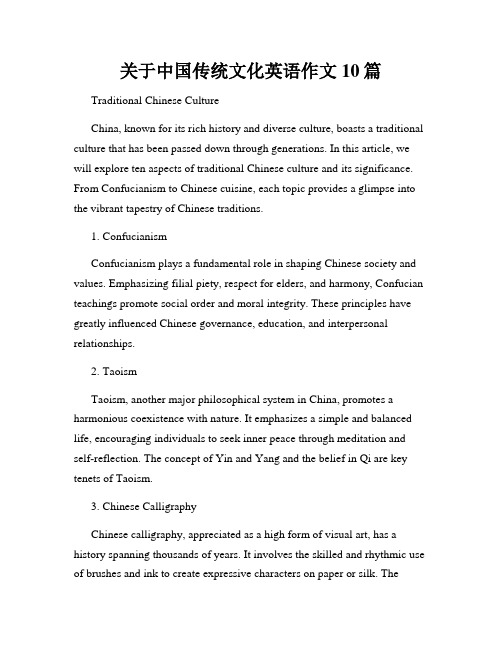
关于中国传统文化英语作文10篇Traditional Chinese CultureChina, known for its rich history and diverse culture, boasts a traditional culture that has been passed down through generations. In this article, we will explore ten aspects of traditional Chinese culture and its significance. From Confucianism to Chinese cuisine, each topic provides a glimpse into the vibrant tapestry of Chinese traditions.1. ConfucianismConfucianism plays a fundamental role in shaping Chinese society and values. Emphasizing filial piety, respect for elders, and harmony, Confucian teachings promote social order and moral integrity. These principles have greatly influenced Chinese governance, education, and interpersonal relationships.2. TaoismTaoism, another major philosophical system in China, promotes a harmonious coexistence with nature. It emphasizes a simple and balanced life, encouraging individuals to seek inner peace through meditation and self-reflection. The concept of Yin and Yang and the belief in Qi are key tenets of Taoism.3. Chinese CalligraphyChinese calligraphy, appreciated as a high form of visual art, has a history spanning thousands of years. It involves the skilled and rhythmic use of brushes and ink to create expressive characters on paper or silk. Thestrokes and structure of each character convey the artist's emotions and aesthetics.4. Traditional FestivalsChina's traditional festivals are an essential part of its cultural identity. Events like the Spring Festival (Chinese New Year), Dragon Boat Festival, and Mid-Autumn Festival not only celebrate the changing seasons but also provide opportunities for family reunions and cultural exchange. Festivals often include vibrant displays of dragon dances, lanterns, and traditional performances.5. Chinese OperaChinese opera, with its distinct music, singing, and intricate costumes, is a combination of theater, music, and dance. It has a history of over 1,000 years and encompasses different regional styles, such as Peking Opera, Yue Opera, and Kunqu Opera. Chinese opera showcases traditional stories, myths, and historical events, and requires highly skilled performers.6. Martial ArtsMartial arts, known as "Wushu" in Chinese, embodies both physical exercise and philosophical principles. Styles such as Tai Chi and Kung Fu emphasize discipline, concentration, and balance. Practitioners not only develop self-defense skills but also cultivate mental and spiritual strength.7. Traditional Chinese MedicineTraditional Chinese Medicine (TCM) is a holistic and ancient approach to healthcare that encompasses various practices. Acupuncture, herbalmedicine, and Qi Gong are integral parts of TCM. TCM focuses on balancing Yin and Yang, promoting the body's self-healing mechanisms, and maintaining overall well-being.8. Tea CultureTea plays a significant role in Chinese culture, symbolizing hospitality, respect, and tranquility. The art of tea preparation and appreciation dates back thousands of years. Chinese tea ceremonies emphasize mindfulness, simplicity, and the enjoyment of the tea's aroma, color, and taste.9. Feng ShuiFeng Shui, an ancient Chinese practice, aims to create harmonious environments by balancing energy flows. It considers factors such as the placement of furniture, colors, and natural elements to optimize the flow of positive energy. Feng Shui is widely believed to bring good luck, enhance health, and promote prosperity.10. Chinese CuisineChinese cuisine is renowned for its diversity, flavors, and cooking techniques. From fiery Sichuan cuisine to delicate Cantonese dim sum, each regional cuisine represents distinctive flavors, ingredients, and cooking methods. The importance of food in Chinese culture is evident through the practice of family-style dining and the symbolism associated with certain dishes.In conclusion, traditional Chinese culture encompasses a range of practices and beliefs that have shaped Chinese society for centuries. From philosophy to the arts, these aspects reflect Chinese values, customs, and adeep-rooted connection to history. Exploring traditional Chinese culture reveals a wealth of traditions and wisdom that continue to influence and inspire people both within and beyond China.。
中国文化 英文介绍(通用3篇)

中国文化英文介绍(通用3篇)关于中国文化的英文文章篇一Lucky number is part of our cultureTo my way of thinking, the so-called lucky number represents the characteristics of our culture. We Chinese have a tradition: whenever we have important things to do, we always select the day we think lucky. Such as: the “10.10.10” day (October 10, 2010), we regard it as the prefect day. For in our culture, “10” as a very lucky number means everything is perfect.This tradition is gradually formed in history. As we all know, china have a very long history. The nature is very sacred then, and our ancestors try their best in order to gain its help, hoping everything run smooth. So when they were to do things, they usually choose something which indicates good fortune. As the time passes, this habit slowly becomes a tradition, and gradually expands every aspect of life. For example, Chinese people like wear the red clothes, because in our eyes the red indicates positive, smooth, prosperous.Among this, the lucky number is the especial example. Now the number seems to appear everywhere in our daily life. Such as: our telephone number, various bank card number, ID number, VIP card number, house number and so on. The number four looked as unlucky, for its pronunciation sound as the word “death” in Chinese. So is the number seven. However, six, nine, ten are lucky numbers. Affected by this culture, most of us prefer to use the so-called lucky numbers. Therefore there are lots of couples choose the”8.8.8”“9.9.9””10.10.10”day when they marry.All in all, the lucky number is part of our culture. All things we can do are holding a respect and accept of attitude to it.中国文化英文介绍篇二京剧脸谱(Beijing opera types of facial makeup in operas)Beijing opera types of facial makeup in operas, is a special feature of a national cosmetic. As each historical figure or a certain type of person has an approximate spectral type, like sing, play music to the music, so called “types of facial makeup in operas”。
给外国朋友介绍中国的传统文化 英语作文
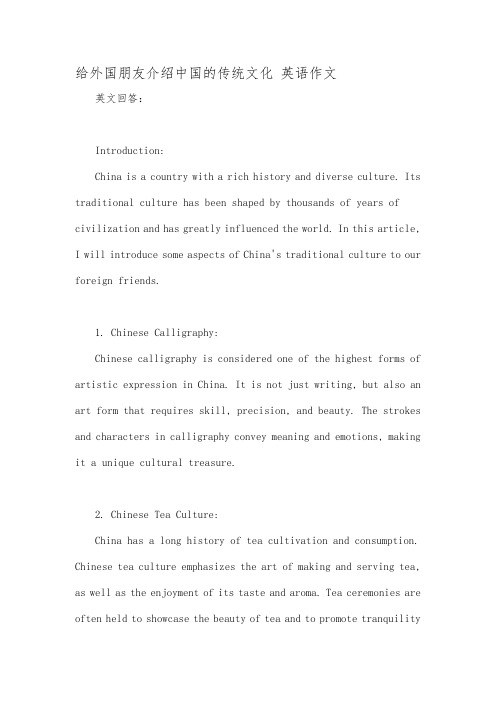
给外国朋友介绍中国的传统文化英语作文英文回答:Introduction:China is a country with a rich history and diverse culture. Its traditional culture has been shaped by thousands of years of civilization and has greatly influenced the world. In this article, I will introduce some aspects of China's traditional culture to our foreign friends.1. Chinese Calligraphy:Chinese calligraphy is considered one of the highest forms of artistic expression in China. It is not just writing, but also an art form that requires skill, precision, and beauty. The strokes and characters in calligraphy convey meaning and emotions, making it a unique cultural treasure.2. Chinese Tea Culture:China has a long history of tea cultivation and consumption. Chinese tea culture emphasizes the art of making and serving tea, as well as the enjoyment of its taste and aroma. Tea ceremonies are often held to showcase the beauty of tea and to promote tranquilityand harmony.3. Chinese Martial Arts:Chinese martial arts, also known as Wushu, have a history of thousands of years. It is not only a physical exercise but also a way to cultivate the mind and spirit. Martial arts such as Tai Chi and Kung Fu are not only about self-defense but also promote discipline, balance, and inner peace.4. Festivals and Traditions:China has numerous traditional festivals that are celebrated with great enthusiasm. The Spring Festival (Chinese New Year), the Lantern Festival, and the Mid-Autumn Festival are some of the most significant ones. These festivals are characterized by vibrant decorations, delicious food, and various cultural activities.Conclusion:China's traditional culture is a treasure trove of wisdom, art, and spirituality. By understanding and appreciating its richness, we can gain a deeper insight into the Chinese way of life. I hope this introduction to China's traditional culture has piqued your interest and encouraged you to explore further.中文回答:简介:中国是一个拥有悠久历史和多元文化的国家。
用英文讲中国文化 英语作文
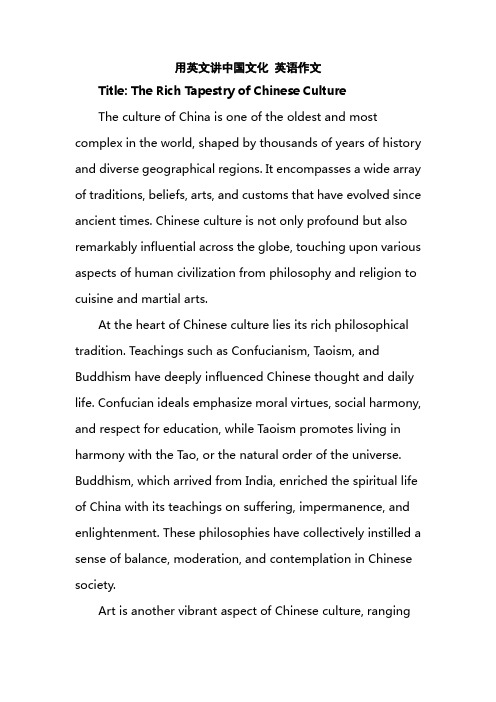
用英文讲中国文化英语作文Title: The Rich Tapestry of Chinese CultureThe culture of China is one of the oldest and most complex in the world, shaped by thousands of years of history and diverse geographical regions. It encompasses a wide array of traditions, beliefs, arts, and customs that have evolved since ancient times. Chinese culture is not only profound but also remarkably influential across the globe, touching upon various aspects of human civilization from philosophy and religion to cuisine and martial arts.At the heart of Chinese culture lies its rich philosophical tradition. Teachings such as Confucianism, Taoism, and Buddhism have deeply influenced Chinese thought and daily life. Confucian ideals emphasize moral virtues, social harmony, and respect for education, while Taoism promotes living in harmony with the Tao, or the natural order of the universe. Buddhism, which arrived from India, enriched the spiritual life of China with its teachings on suffering, impermanence, and enlightenment. These philosophies have collectively instilled a sense of balance, moderation, and contemplation in Chinese society.Art is another vibrant aspect of Chinese culture, rangingfrom the intricate designs on traditional ceramics to the grandeur of calligraphy and painting. Chinese calligraphy is more than just a form of writing; it is considered a dance of the brush, where each stroke embodies strength, rhythm, and emotion. Paintings often feature landscapes, imbued with philosophical meanings and a deep appreciation for nature's beauty. Traditional Chinese music, with its unique pentatonic scale, has been used to create melodies that are both soothing and expressive, often accompanied by instruments such as the pipa, an ancestor of the modern guitar, or the erhu, atwo-stringed bowed instrument.Celebrations and festivals occupy a special place in Chinese culture, serving both as markers of the passage of time and as opportunities for family reunions. The Spring Festival, or Chinese New Year, is the most significant event, a time when people welcome the new lunar year with fireworks, feasting, and family gatherings. The Mid-Autumn Festival celebrates the harvest moon with the gifting and consumption of mooncakes, symbolizing unity and completeness. These occasions, along with others like the Dragon Boat Festival and Qingming Festival, showcase the importance of kinship and communal solidarity.Chinese cuisine is perhaps one of the most widespread and beloved elements of Chinese culture globally. It varies vastly by region, reflecting the country's vast geography and climate differences. Signature dishes like Peking duck from the north and spicy Sichuan fare from the southwest offer a taste of China's culinary diversity. Rice, noodles, tea, and soups are staples in everyday meals, demonstrating the Chinese emphasis on balance and healthfulness in diet.Martial arts, often referred to in the West as "kung fu," are a testament to the Chinese philosophy of physical and spiritual discipline. Styles like Tai Chi combine self-defense techniques with principles of meditation and inner peace, making them both a physical exercise and a spiritual practice. Other forms, such as Shaolin martial arts, highlight a combination of agility, strength, and aerobic stamina, showcasing the athleticism and grace inherent in these practices.In conclusion, Chinese culture is a magnificent mosaic of historical depth, artistic splendor, philosophical profundity, and communal harmony. Its influence stretches far beyond China's borders, captivating and inspiring people around the globe. As one delves into the rich tapestry of China's culturalheritage, it becomes evident that this ancient culture embodies enduring wisdom and a way of life that values balance, reflection, and continuity with the past while embracing modernity and innovation.。
高中英语 高考英语作文有关中国传统文化的范文5篇带中文翻译
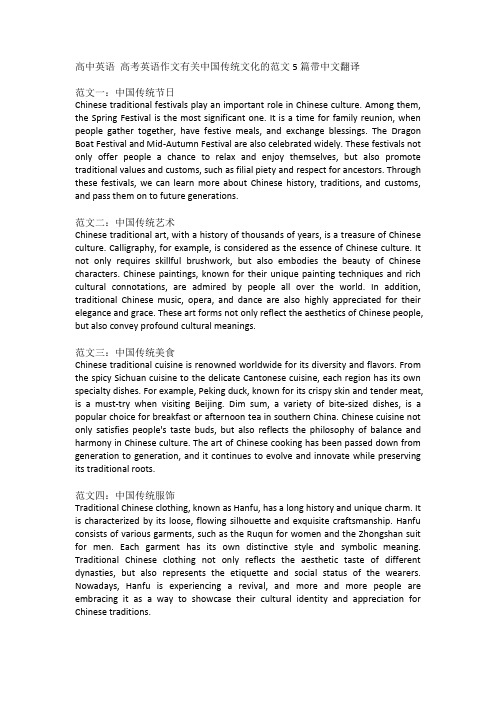
高中英语高考英语作文有关中国传统文化的范文5篇带中文翻译范文一:中国传统节日Chinese traditional festivals play an important role in Chinese culture. Among them, the Spring Festival is the most significant one. It is a time for family reunion, when people gather together, have festive meals, and exchange blessings. The Dragon Boat Festival and Mid-Autumn Festival are also celebrated widely. These festivals not only offer people a chance to relax and enjoy themselves, but also promote traditional values and customs, such as filial piety and respect for ancestors. Through these festivals, we can learn more about Chinese history, traditions, and customs, and pass them on to future generations.范文二:中国传统艺术Chinese traditional art, with a history of thousands of years, is a treasure of Chinese culture. Calligraphy, for example, is considered as the essence of Chinese culture. It not only requires skillful brushwork, but also embodies the beauty of Chinese characters. Chinese paintings, known for their unique painting techniques and rich cultural connotations, are admired by people all over the world. In addition, traditional Chinese music, opera, and dance are also highly appreciated for their elegance and grace. These art forms not only reflect the aesthetics of Chinese people, but also convey profound cultural meanings.范文三:中国传统美食Chinese traditional cuisine is renowned worldwide for its diversity and flavors. From the spicy Sichuan cuisine to the delicate Cantonese cuisine, each region has its own specialty dishes. For example, Peking duck, known for its crispy skin and tender meat, is a must-try when visiting Beijing. Dim sum, a variety of bite-sized dishes, is a popular choice for breakfast or afternoon tea in southern China. Chinese cuisine not only satisfies people's taste buds, but also reflects the philosophy of balance and harmony in Chinese culture. The art of Chinese cooking has been passed down from generation to generation, and it continues to evolve and innovate while preserving its traditional roots.范文四:中国传统服饰Traditional Chinese clothing, known as Hanfu, has a long history and unique charm. It is characterized by its loose, flowing silhouette and exquisite craftsmanship. Hanfu consists of various garments, such as the Ruqun for women and the Zhongshan suit for men. Each garment has its own distinctive style and symbolic meaning. Traditional Chinese clothing not only reflects the aesthetic taste of different dynasties, but also represents the etiquette and social status of the wearers. Nowadays, Hanfu is experiencing a revival, and more and more people are embracing it as a way to showcase their cultural identity and appreciation for Chinese traditions.范文五:中国传统建筑Chinese traditional architecture, with its distinctive style and profound cultural connotations, is a true representation of Chinese culture. The Forbidden City in Beijing, with its grandeur and meticulous design, is a masterpiece of traditional Chinese architecture. The classical gardens in Suzhou, known for their harmonious layout and exquisite details, showcase the perfect integration of nature and human creations. Traditional Chinese architecture also emphasizes the balance of Yin and Yang, and the harmony between man and nature. It is not only a manifestation of architectural skills, but also a reflection of the wisdom and philosophy of the Chinese people.范文一:中国传统节日中国传统节日在中国文化中占有重要地位。
介绍中国文化的英文作文80字
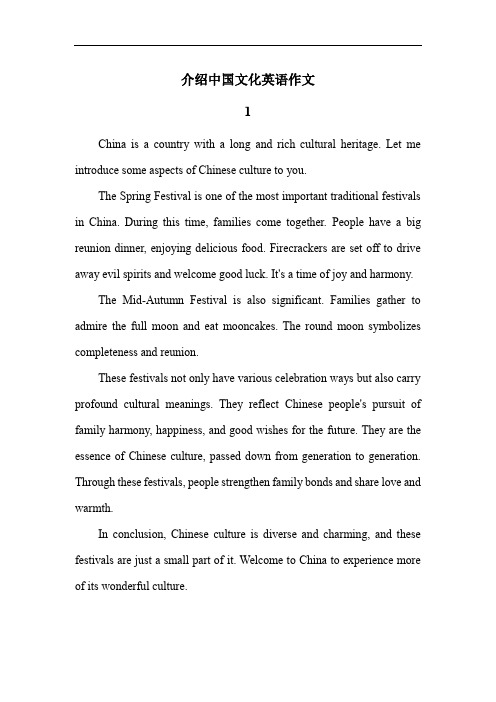
介绍中国文化英语作文1China is a country with a long and rich cultural heritage. Let me introduce some aspects of Chinese culture to you.The Spring Festival is one of the most important traditional festivals in China. During this time, families come together. People have a big reunion dinner, enjoying delicious food. Firecrackers are set off to drive away evil spirits and welcome good luck. It's a time of joy and harmony.The Mid-Autumn Festival is also significant. Families gather to admire the full moon and eat mooncakes. The round moon symbolizes completeness and reunion.These festivals not only have various celebration ways but also carry profound cultural meanings. They reflect Chinese people's pursuit of family harmony, happiness, and good wishes for the future. They are the essence of Chinese culture, passed down from generation to generation. Through these festivals, people strengthen family bonds and share love and warmth.In conclusion, Chinese culture is diverse and charming, and these festivals are just a small part of it. Welcome to China to experience more of its wonderful culture.China is a country with a long and rich cultural history. One of the most remarkable aspects of Chinese culture is its diverse and exquisite art forms.Calligraphy, for instance, is an art that reflects the beauty and depth of Chinese characters. The works of Wang Xizhi, a renowned calligrapher, are highly praised for their elegance and precision. His strokes are like a dance of the brush on paper, expressing the artist's emotions and thoughts.Painting is another splendid form of art. Chinese painters use traditional techniques and materials to create vivid and meaningful scenes. Their works often convey the harmony between humans and nature.Chinese opera, especially Peking Opera, is a unique performing art. The performances of Mei Lanfang, a famous Peking Opera master, are still unforgettable. His exquisite gestures, beautiful singing, and vivid expressions have left a deep impression on audiences.These art forms not only showcase the creativity and talent of the Chinese people but also carry the wisdom and spirit of the nation. They are the treasures of Chinese culture, attracting people from all over the world to explore and appreciate. Through these art forms, we can better understand the profound and charming Chinese culture.China has a rich and diverse culinary culture that is truly remarkable. Among the various aspects of Chinese cuisine, the Eight Culinary Traditions stand out with their unique characteristics and famous dishes.Sichuan cuisine is known for its bold and spicy flavors. Dishes like Mapo Tofu and Spicy Chicken are beloved for their intense heat and rich taste. The numbing spiciness of Sichuan peppers adds an unforgettable experience to the palate.Cantonese cuisine, on the other hand, emphasizes delicacy and refinement. Roast Goose and Dim Sum are prime examples of its exquisite cooking techniques and attention to detail. The fresh ingredients and delicate seasonings make each bite a treat.Shandong cuisine is famous for its emphasis on freshness and natural flavors. Braised Sea Cucumber and Sweet and Sour Pork are among its signature dishes.Huaiyang cuisine showcases the elegance and sophistication of Chinese cooking. Stewed Pork Balls and Yangzhou Fried Rice are popular choices.Each of the Eight Culinary Traditions offers a distinct flavor profile and reflects the regional diversity and cultural heritage of China. The exploration of Chinese cuisine is like a journey through a flavorful landscape, where every dish tells a story of tradition and innovation. It isnot only a source of sustenance but also a window into the depth and breadth of Chinese culture.4China has a profound and long-standing cultural heritage, among which philosophical thoughts play a vital role. Confucianism, represented by Confucius, emphasizes the concept of "benevolent governance". This idea holds that rulers should treat their subjects with kindness and morality, focusing on education and moral cultivation to create a harmonious society. For instance, providing equal opportunities for education and promoting moral standards among the people are key aspects of this thought.Another significant philosophy is Taoism, with Laozi advocating for "governing by doing nothing that goes against nature". It suggests that rather than excessive interference and control, one should follow the natural course of things and allow them to develop spontaneously. This approach emphasizes finding balance and harmony with nature, and not forcing outcomes.These philosophical ideas have not only influenced China's historical development but also have far-reaching implications for the modern world. They offer valuable insights into governance, interpersonal relationships, and the pursuit of a peaceful and balanced life. They remind us to respect nature, value morality, and strive for harmony in all aspects of life.5China is a country with a long history and rich culture. Among the many aspects that showcase its splendid civilization, traditional architecture stands out. Take the Forbidden City and the Great Wall as examples.The Forbidden City, an imperial palace complex, is a masterpiece of ancient Chinese architecture. Its elaborate design and magnificent buildings reveal the supreme power and exquisite taste of the emperors. Every detail, from the roof tiles to the carved pillars, is a testament to the superb craftsmanship of that era.The Great Wall is another remarkable symbol. Built over centuries, it has a profound history. Originally constructed for defense purposes, it has withstood the test of time and witnessed countless battles and changes. The massive stones and bricks were carefully laid, forming a barrier that stretches across mountains and valleys. It not only served as a military fortification but also became a cultural icon, representing the indomitable spirit and perseverance of the Chinese people.These traditional buildings are not just structures; they are the embodiment of Chinese wisdom, culture, and history. They tell stories of the past and inspire future generations to cherish and carry forward the precious heritage.。
- 1、下载文档前请自行甄别文档内容的完整性,平台不提供额外的编辑、内容补充、找答案等附加服务。
- 2、"仅部分预览"的文档,不可在线预览部分如存在完整性等问题,可反馈申请退款(可完整预览的文档不适用该条件!)。
- 3、如文档侵犯您的权益,请联系客服反馈,我们会尽快为您处理(人工客服工作时间:9:00-18:30)。
• Dragon • Forbidden City • Great Wall • Shaolin Temple • Chopsticks • Spring Festival • Qingming Festival • Duanwu Festival • Mid-Autumn Festival Mid-
Forbidden City
• • • • • • • • • • The Forbidden City was the Chinese imperial palace from the Ming Dynasty to the end of the Qing Dynasty. It is located in the middle of Beijing, China, and now houses the Palace Museum. For almost five hundred years, it served as the home of emperors and their households, as well as the ceremonial and political center of Chinese government. The palace complex exemplifies traditional Chinese palatial architecture,and has influenced cultural and architectural developments in East Asia and elsewhere. The Forbidden City was declared a World Heritage Site in 1987,and is listed by UNESCO (联合国科教文组织) as the largest collection of preserved ancient wooden structures in the world.
Fenghuang
• Fenghuang are mythological birds of East Asia that reign over all other birds. The males are called Feng and the females Huang. In modern times, however, such a distinction of gender is often no longer made and the Feng and Huang are blurred into a single feminine entity so that the bird can be paired with the Chinese dragon, which has male connotations. • In ancient and modern Chinese culture, they can often be found in the decorations for weddings or royalty, along with dragons. This is because the Chinese considered the dragon and phoenix symbolic of blissful(极幸福的) relations between husband and wife, another common yin and yang metaphor. • “Dragon and Phoenix infants” (龙凤胎) is an expression meaning a set of male and female fraternal twins(异卵双生).
Chinese folklore
• Chinese folklore includes songs, dances, puppetry(木偶戏), and tales. It often tells stories of human nature, historical or legendary events, love, and the supernatural, or stories explaining natural phenomena and distinctive landmarks. • The main influences on Chinese folk tales have been Taoism(道教), Confucianism(儒教) and Buddhism(佛教). • Well-known Chinese folk tales include: • The story of Qi Xi(七夕), also known as the Story of the Magpie Bridge(鹊桥) or the Story of Cowherd(牛郎) and the Weaving Maid(织 女), which tells how the stars Altair(牵牛星) and Vega(织女星) came to their places in the sky. • The story of Hua Mulan(花木兰), the female warrior who disguised herself as a man. • The story of Chang'e(嫦娥), the goddess of the moon. • The story of the Magic Paintbrush(神笔马良). • The story of Meng Jiangnü(孟姜女), the woman who sought her husband at the Great Wall. • The story of Sun Wukong(孙悟空), the Monkey King - from the popular novel Journey to the West(《西游记》).d Nhomakorabeaagon
• Chinese dragons are legendary creatures in Chinese mythology and folklore.In Chinese art, dragons are typically portrayed as long, scaled, serpentine creatures with four legs. In yin and yang terminology(术语), a dragon is yang and complements a yin fenghuang “Chinese phoenix(长 生鸟)". • In Chinese daily language, excellent and outstanding people are compared to the dragon while incapable people with no achievements are compared with other, disesteemed creatures, such as the worm. A number of Chinese proverbs and idioms feature references to • the dragon, for example: “Hoping one‘s son will • become a dragon” (望子成龙). • Many Chinese people often use the term • “Descendants of the Dragon” (龙的传人) • as a sign of ethnic identity, as part of a trend • started in the 1970s when different Asian • nationalities were looking for animal • symbols for representations.The wolf • was used among the Mongols(蒙古), the monkey among Tibetans(西藏).
Great Wall
• • • • • • • • The Great Wall of China is a series of stone and earthen fortifications in northern China, built originally to protect the northern borders of the Chinese Empire against intrusions by various nomadic groups. Several walls have been built since the 5th century BC that are referred to collectively as the Great Wall, which has been rebuilt and maintained from the 5th century BC through the 16th century. One of the most famous is the wall built between 220–206 BC by the first Emperor of China, Qin Shi Huang. Little of that wall remains; the majority of the existing wall was built during the Ming Dynasty.
Chinese Classical Garden
• The Chinese Classical Garden is a place for solitary or social contemplation of nature. • Chinese gardens were created in the same way as a combination of landscape and paintings together with poems - this was the so-called “poetic garden.” The design of Chinese gardens was to provide a spiritual utopia(乌托邦) for one to connect with nature, to come back to one‘s inner heart, to come back to ancient idealism. Chinese gardens are a spiritual shelter for people, a place they could be far away from their real social lives, and close to the ancient way of life, their true selves, and nature. This was an escape from the frustration and disappointment of the political problems in China. They used plants as symbols. Bamboo(竹子) was used in every traditional Chinese garden. This is because bamboo represents a strong but resilient(达观的) character. Often pine(松树) is used to represent longevity(长寿), persistence, tenacity(坚韧) and dignity(庄严). The lotus(莲花) is used to symbolize purity. Flowering peaches(碧桃花) are grown for spring color, and sweet olive(橄榄) as well. The chrysanthemum(菊花) is used to symbolize splendor, luster(光 彩) and "the courage to make sacrifices for a natural life". Peonies(牡丹) symbolize wealth and banana trees are used simply for the sound they make in the breeze.
